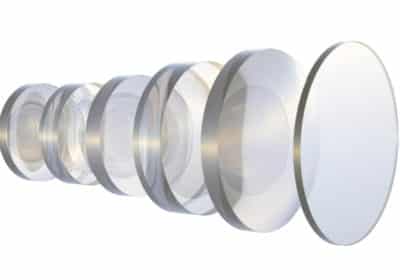The glass types selected for an optical component or system can have a noticeable impact on price, lead time (both initially and on an on-going basis), manufacturing yield and performance.
In our experience of designing and manufacturing many thousands of custom optics over 40 years, customers come to us with designs that are optimized for performance but not always balanced by the impact on cost and delivery. The following are suggestions and things to think about to help you achieve that balance.
GLASS TYPES
There are currently hundreds of different glass types available with prices ranging from $9 to more than $780 per pound. The percentage contribution of glass to the total cost of the optic varies.
In the case of a large optic that uses rare glasses, it can be 70% or more. Typically, the range is 20%-30%. In either case it’s a significant cost factor. And, that’s just the direct cost. There are also the indirect costs of manufacturing yield and availability.
SET A PRICE CAP
The leading optical design software packages (e.g. Zemax and Code V) offer a feature that allows you to set a “not to exceed” price when the software runs its glass selection routine. If you don’t like the resulting performance you can always raise the price cap.
By starting with the lower price glasses you’re more likely to find the sweet spot between performance and cost.
Use the glass manufacturer’s Melt Frequency-Relative Price Chart to manually create custom glass substitution catalogs in your lens design software program. The program will only use glasses from this list when evaluating alternate glass types.
CHECK OUT GLASS AVAILABILITY
Each of the major glass manufacturers (e.g. Schott and Ohara) publishes melt frequency data (see Ohara example) for their glass types. Consulting this information is important since the preference is to use more readily available glass types. This will shorten initial delivery as well as improve lead time for subsequent production.
An additional step is to call your optics vendor. They buy glass regularly and are in contact with the glass makers and their resellers on an on-going basis. They have a good sense of glass availability and, if in doubt, can get in touch with their glass source for more information.
AVOID (IF YOU CAN) GLASSES THAT STAIN EASILY
Some glass types are more susceptible to staining during manufacturing. Stains can result from environmental conditions in the manufacturing area (e.g. high humidity) or from the polishing compounds used to make the optic. Optics makers are constantly improving their manufacturing processes and environmental controls to minimize these impacts. However, you can help your project by selecting glass that has good environmental resistance characteristics.
GLASS MANUFACTURERS
There are only a few companies that make a full range of optical grade glasses. Schott, OHARA, CDGM, Pilkington, Hoya are the principle players. They each have their pluses and minuses with respect to breadth of product line, consistency across melts, delivery, availability and price (as much as 30%).
SPECIFY A GLASS MANUFACTURER AS A LAST RESORT
The major glass makers offer comparable product lines of glass types which means you have options. It will help your optics manufacturing vendor do their best work for you if you give them the choice of which glass maker to use. They can apply their experience and knowledge about optical glasses to your products and build flexibility into your program throughout its lifecycle. If there is a shortage or delivery delay from a given glass manufacturer, you may be able to avoid late deliveries to your customer by switching to the more available equivalent glass.
ASK
If you decide that you need to specify a glass manufacturer for your optic, it’s worthwhile to get your optics manufacturer’s recommendations. You’ll be better served by specifying a glass manufacturer that has the confidence of your optics maker.
DISPERSION AND INDEX OF REFRACTION TOLERANCES
Customer will sometimes request optics with index of refraction and/or dispersion tolerances that are tighter than standard, and beyond what the application requires. Often the tighter tolerances are boilerplate on the customer’s drawing. In order to achieve tighter tolerances, glass manufacturer’s do a post-production sorting. This translates to more cost and potentially limited availability. The standard tolerances offered by the major glass manufacturers are adequate for the large majority of applications.
Unless your tolerance analysis suggests that the design is sensitive to index of refraction or dispersion variations, you should be able to use glass with standard tolerances and get great results.
Standard Index of Refraction Tolerance (Nd) = 0.0005
Standard Dispersion Tolerance (Vd) = +/- 0.5%
HOMOGENEITY
The smaller the optic the less likely it is that it’s worth paying for a higher than standard homogeneity classification. Homogeneity is the variation in index across the glass blank. Since the rate of variation is small, the smaller the optic the less value there is in having a homogeneity certification. Essentially you’re paying to certify something that you are getting anyway.
RULE OF THUMB
We use the rule of thumb that an optic with a diameter less than 1” or 2” does not require higher homogeneity. Larger sizes are dependent on the application requirement.
SIZE
The reasons size matters with respect to glass are twofold. First, the obvious – larger optics require more material resulting in a proportionately higher material bill. The other reason is based on the standard slab size of raw glass. Glass manufacturers produce raw glass in slabs. If your design requires an optic larger than the standard size will yield, the glass manufacturer needs to deviate from their normal manufacturing processes. This translates to higher cost, longer lead times and availability issues.
DESIGN TO STANDARD SIZES
If your application requires optics that clearly exceed the standard slab size, then it is what it is. If not, then it may be worth a few additional design iterations to see if you can get within that standard size.

